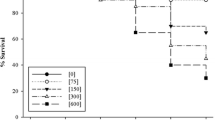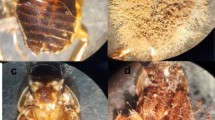Abstract
Baylisascaris procyonis is a soil-transmitted helminth mainly found in raccoons (Procyon lotor) which can also affect other domestic and sylvatic animals, as well as humans, when the eggs released in the feces of parasitized raccoons are accidentally ingested. Three assays have been conducted to assess the effect of three saprophytic fungi, Mucor circinelloides, Paecilomyces lilacinus, and Verticillium sp., on the eggs of B. procyonis. Firstly, their ovicidal effect was in vitro ascertained by placing 1 mL with 2 × 106 spores of each fungus in Petri plates with water-agar (2 %) and simultaneously adding 200 eggs of Baylisascaris/plate. Two in vivo probes were carried out, by spraying the fungal spores (3 mL containing about 2 × 106 spores/mL) on the feces of raccoons and coatis (Nasua narica) passing eggs of B. procyonis in a zoological park; the other assay consisted of evaluating the activity of the fungi after adding sand to fecal samples from raccoons. An ovicidal type 3 activity characterized by morphological damage of the eggshell with hyphal penetration, internal egg colonization, and embryo alteration was observed for all the tested fungi. In the plate assays, viability of Baylisascaris eggs reduced significantly by 53–69 % with Mucor, 45–62 % with Paecilomyces, and 52–67 % with Verticillium. A similar ovicidal effect was detected in the feces with sand. These results demonstrate the usefulness of spraying spores of M. circinelloides, Pa. lilacinus, or Verticillium sp. on the feces of animals infected by Baylisascaris to decrease the numbers of viable eggs and, thus, the risk of infection.


Similar content being viewed by others
References
Arias MS, Cazapal-Monteiro CF, Suárez J, Miguélez S, Francisco I, Arroyo FL, Suárez JL, Paz-Silva A, Sánchez-Andrade R, Mendoza de Gives P (2013) Mixed production of filamentous fungal spores for preventing soil-transmitted helminth zoonoses: a preliminary analysis. Biomed Res Int. doi:10.1155/2013/567876
Blaszkowska J, Wojcik A, Kurnatowski P, Szwabe K (2013) Biological interactions between soil saprotrophic fungi and Ascaris suum eggs. Vet Parasitol 196:401–408
Blizzard EL (2010) Distribution, prevalence, and genetic characterization of Baylisascaris procyonis in selected areas of Georgia and Florida. MSc thesis, University of Georgia, pp 77.
Braga FR, Araújo JV, Carvalho RO, Silva AR, Araujo JM, Soares FE, Geniêr HL, Ferreira SR, Queiroz JH (2010) Predatory activity of Pochonia chlamydosporia fungus on Toxocara (syn. Neoascaris) vitulorum eggs. Trop Anim Health Prod 42:309–314
Braga FR, Araújo JV, Araujo JM, Frassy LN, Tavela AO, Soares FE, Carvalho RO, Queiroz LM, Queiroz JH (2012) Pochonia chlamydosporia fungal activity in a solid medium and its crude extract against eggs of Ascaridia galli. J Helminthol 86:348–352
Carvalho RO, Araújo JV, Braga FR, Araujo JM, Alves CD (2010) Ovicidal activity of Pochonia chlamydosporia and Paecilomyces lilacinus on Toxocara canis eggs. Vet Parasitol 169:123–127
Ciarmela ML, Minvielle MC, Lori G, Basualdo JA (2002) Biological interaction between soil fungi and Toxocara canis eggs. Vet Parasitol 103:251–257
Cruz LM, Allanson M, Kwa B, Azizan A, Izurieta R (2012) Morphological changes of Ascaris spp. eggs during their development outside the host. J Parasitol 98:63–68
De Hoog GS, Guarro J, Gene E, Figueras MJ (2000) Atlas of clinical fungi, 2nd edn. Centraalbureau voor Schimmelcultures, Utrecht
De Souza Maia Filho F, Nunes Vieira J, Aires Berne ME, Stoll FE, Da Silva NP, Pötter L, Brayer Pereira DI (2013) Fungal ovicidal activity on Toxocara canis eggs. Rev Iberoam Micol 30:226–230
Evans RH (2002) Baylisascaris procyonis (Nematoda: Ascarididae) larva migrans in free-ranging wildlife in Orange County, California. J Parasitol 88:299–301
Ferreira SR, Araújo JV, Braga FR, Araujo JM, Carvalho RO, Silva AR, Frassy LN, Freitas LG (2011) Ovicidal activity of seven Pochonia chlamydosporia fungal isolates on Ascaris suum eggs. Trop Anim Health Prod 43:639–642
García JT, García FJ, Alda F, González JL, Aramburu MJ, Cortés Y et al (2011) Recent invasion and status of the raccoon (Procyon lotor) in Spain. Biol Invasions. doi:10.1007/s10530-011-0157-x
Gavin PJ, Kazacos KR, Tan TQ, Brinkman WB, Byrd SE, Davis AT, Mets MB, Shulman ST (2002) Neural larva migrans caused by the raccoon roundworm Baylisascaris procyonis. Pediatr Infect Dis J 21:971–975
Gavin PJ, Shulman ST (2003) Raccoon roundworm (Baylisascaris procyonis). Pediatr Infect Dis J 22:651–652
Gavin PJ, Kazacos KR, Shulman ST (2005) Baylisascariasis. Clin Microbiol Rev 18:703–718
Kazacos KR (2001) Baylisascaris procyonis and related species. In: Samuel WM, Pybus MJ, Kocan KK (eds) Parasitic diseases of wild mammals. Iowa State University Press, Ames, p 559
Kazacos KR, Boyce WM (1989) Baylisascaris larva migrans. J Am Vet Med Assoc 195:894–903
LoGiudice K (2001) Latrine foraging strategies of two small mammals: implications for the transmission of Baylisascaris procyonis. Am Midl Nat 146:369–378
López-Llorca LV, Maciá-Vicente JG, Jansson H-B (2007) Nematophagous fungi: mode of action and interactions. In: Ciancio A, Mukerji KG (eds) General concepts in integrated pest and disease management. Springer, Netherlands, pp 43–59
Lýsek H, Fassatiová O, Cuervo Pineda N, Lorenzo Hernández N (1982) Ovicidal fungi in soils of Cuba. Folia Parasitol 29:265–270
Maya C, Ortiz M, Jiménez B (2010) Viability of Ascaris and other helminth genera non larval eggs in different conditions of temperature, lime (pH) and humidity. Water Sci Technol 62:2616–2624
Mazurkiewicz-Zapałowicz K, Jaborowska-Jarmoluk M, Kołodziejczyk L, Kuźna-Grygiel W (2014) Comparison of the effect of the chosen species of saprotrophic fungi on the development of Toxocara canis and Ascaris suum eggs. Ann Parasitol 60:215–220
Mitchell MA, Hungeford LL, Nixon C, Esker T, Sullivan J, Koerkenmeier R, Dubey JP (1999) Serologic survey for selected infectious disease agents in raccoons from Illinois. J Wildlife Dis 35:347–355
Monfort E, López-Llorca LV, Janson HB, Salinas J (2006) In vitro soil receptivity assays to egg-parasitic nematophagous fungi. Mycol Progress 5:18–23
Morrondo P, Díez-Morrondo C, Pedreira J, Díez-Baños N, Sánchez-Andrade R, Paz-Silva A, Díez-Baños P (2006) Toxocara canis larvae viability after disinfectant-exposition. Parasitol Res 99:558–561
Murray WJ (2002) Human infections caused by the raccoon roundworm, Baylisascaris procyonis. Clin Microbiol News 24:1–7
Murray WJ, Kazacos KR (2004) Raccoon roundworm encephalitis. Clin Infect Dis 39:1484–1492
Okulewicz A, Buńkowska K (2009) Baylisascariasis—a new dangerous zoonosis. Wiad Parazytol 55:329–334
Page LK, Gehrt SD, Titcombe KK, Robinson NP (2005) Measuring prevalence of raccoon roundworm (Baylisascaris procyonis): a comparison of common techniques. Wildl Soc Bull 33:1406–1412
Page LK, Anchor C, Luy E, Kron S, Larson G, Madsen L, Kellner K, Smyser TJ (2009) Backyard raccoon latrines and risk for Baylisascaris procyonis transmission to humans. Emerg Infect Dis 15:1530–1531
Page K, Beasley JC, Olson ZH, Smyser TJ, Downey M, Kellner KF, McCord SE, Egan TS 2nd, Rhodes OE Jr (2011) Reducing Baylisascaris procyonis roundworm larvae in raccoon latrines. Emerg Infect Dis 17:90–93
Page K, Smyser TJ, Dunkerton E, Gavard E, Larkin B, Gehrt S (2014) Reduction of Baylisascaris procyonis eggs in raccoon latrines, suburban Chicago, Illinois, USA. Emerg Infect Dis 20:2137–2140
Rentería-Solís ZM, Hamedy A, Michler FU, Michler BA, Lücker E, Stier N, Wibbelt G, Riehn K (2013) Alaria alata mesocercariae in raccoons (Procyon lotor) in Germany. Parasitol Res 112:3595–3600
Roussere GP, Murray WJ, Raudenbush CB, Kutilek MJ, Levee DJ, Kazacos KR (2003) Raccoon roundworm eggs near homes and risk for larva migrans disease, California communities. Emerg Infect Dis 9:1516–1522
Sato H, Kamiya H, Furuoka H (2003) Epidemiological aspects of the first outbreak of Baylisascaris procyonis larva migrans in rabbits in Japan. J Vet Med Sci 65:453–457
Sato H, Une Y, Kawakami S, Saito E, Kamiya H, Akao N, Furuoka H (2005) Fatal Baylisascaris larva migrans in a colony of Japanese macaques kept by a safari-style zoo in Japan. J Parasitol 91:716–719
Shafir SC, Wang W, Sorvillo FJ, Wise ME, Moore L, Sorvillo T, Eberhard ML (2007) Thermal death point of Baylisascaris procyonis eggs. Emerg Infect Dis 13:172–173
Shafir SC, Sorvillo FJ, Sorvillo T, Eberhard ML (2011) Viability of Baylisascaris procyonis eggs. Emerg Infect Dis 17:1293–1295
Sorvillo F, Ash LR, Berlin OGW, Yatabe J, Degiorgio C, Mores SA (2002) Baylisascaris procyonis: an emerging helminthic zoonosis. Emerg Infect Dis 8:355–359
Thompson AB, Glover GJ, Postey RC, Sexsmith JL, Hutchison TW, Kazacos KR (2008) Baylisascaris procyonis encephalitis in Patagonian conures (Cyanoliseus patagonus), crested screamers (Chauna torquata), and a western Canadian porcupine (Erethizon dorsatum epixanthus) in a Manitoba zoo. Can Vet J 49:885–888
Thrusfield M (2007) Veterinary epidemiology, 3rd edn. Blackwell, Oxford
Acknowledgments
This work was partially supported by the Research Project AGL2012-34355 (Ministerio de Economía y Competitividad, Spain; FEDER) and complies with the current laws for Animal Health Research in Spain. Dr. Arias has received a fellowship from the “Parga Pondal” Research Program (XUGA, Spain). We thank Mrs. B. Valcárcel for preparing and editing the manuscript.
Author information
Authors and Affiliations
Corresponding author
Rights and permissions
About this article
Cite this article
Cazapal-Monteiro, C.F., Hernández, J.A., Arroyo, F.L. et al. Analysis of the effect of soil saprophytic fungi on the eggs of Baylisascaris procyonis . Parasitol Res 114, 2443–2450 (2015). https://doi.org/10.1007/s00436-015-4440-0
Received:
Accepted:
Published:
Issue Date:
DOI: https://doi.org/10.1007/s00436-015-4440-0




